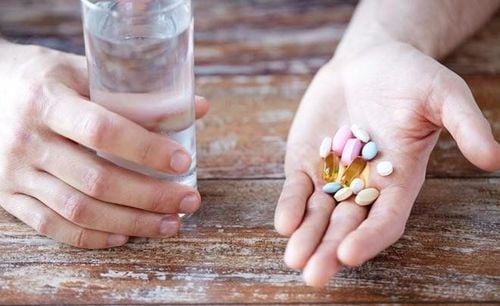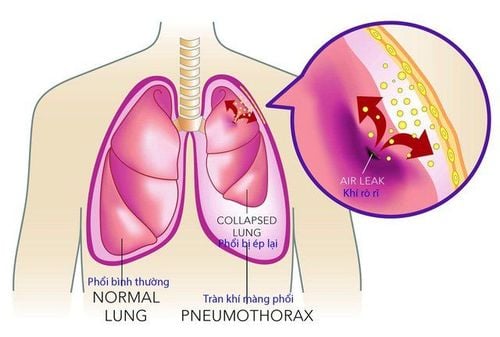This is an automatically translated article.
Our lungs work day and night, non-stop to provide enough oxygen needed for the body. Lungs play a very important role, but you do not really understand all about your lungs. Let's learn about the lungs through the article below.
1. What is the structure and function of the lungs?
Every day we do about 20,000 breaths so that the body can receive enough oxygen for the body. A surprising number is that by the age of 50, you have breathed about 400 million times. The lungs are made of a special sponge-like tissue that can stretch easily and keep its shape without damage. Lungs are divided into right lung and left lung:
Right lung is divided into 3 lobes. When we inhale, each lobe expands like a balloon and collapses when we exhale. The left lung is slightly smaller than the right lung, divided into two lobes, and it is close to the heart. The structure of the two lungs includes:
Bronchial tree: In the lung, each large bronchial tube branches into many smaller bronchial tubes and continues to divide further like a maze. Inside the lumen of the bronchi is a layer of epithelium and there are small hairs inside called cilia. The cilia help trap dust and microorganisms out when you cough, sneeze, or swallow. In the structure of the bronchial tree, the smallest tubes are called bronchioles. These bronchioles end in small air sacs called alveoli. This is where your lungs supply oxygen to your blood and take back carbon dioxide (CO2) to pass out. Alveoli: Alveoli are a small air sac, located at the end of the bronchial tree. In our bodies there are hundreds of millions of these tiny sacs in each lung. Inside the alveoli there are vessels are small blood vessels called capillaries, through which there will be an exchange of oxygen entering the blood and CO2 out. When our lungs are damaged by agents such as smoking, chemicals, mold, bacteria or viruses such as corona virus, the alveoli are often broken, making it difficult to exchange oxygen. difficulty, so the body will be deprived of oxygen and causing difficulty breathing, rapid breathing... Pleural: The pleura is a very thin and smooth membrane, consisting of two separate layers, one covering the outside of each lobe of the lung and the other. an inner lining of the chest cavity. Between the two pleura, there is a thin layer of fluid that separates the pleura from each other. This makes it easier for the lungs to continue to slide smoothly and evenly as they expand and contract. When the amount of fluid between these two membranes increases for some reason, it will make the lungs difficult to expand and it is called pleural effusion. Two healthy lungs ensure the function of providing necessary oxygen to the body and eliminating CO2 for the body. Every cell in our body wants to maintain its best function, it needs oxygen, in other words, the lungs are very important to the life of the body.
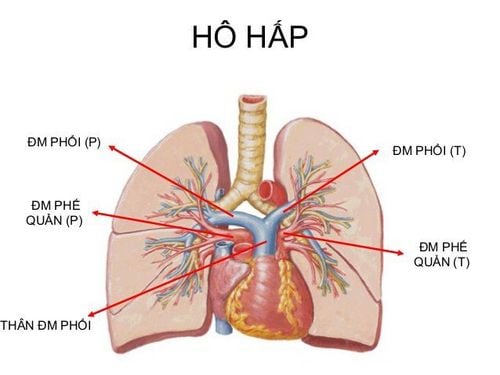
Cấu tạo của phổi
2. Where are the two lungs located?
Our lungs are located in the thoracic cavity (thoracic cavity) this is the space that contains and protects the heart and lungs. The structure of the ribcage includes the ribs and the muscles of the chest to form the upper part, the sides; The lower part of the ribcage is made up of a large muscle called the diaphragm. In the center of the ribcage called the mediastinum is the place where the heart, thymus, and several other parts are located. It also helps separate the two lungs so that if one lung is punctured or damaged, the other lung can still function on its own and meet the body's oxygen needs.
3. How does breathing work?
When inhaling air through the nose, the tiny hairs on the nose help remove dust and germs. Air is brought through the sinuses to help the air have the right temperature and humidity before it enters the lungs. Air also enters through your mouth, especially during exercise or if you have a stuffy nose. Whether through the nose or mouth, the air next passes through the throat and into the trachea, then to the bronchi, bronchioles, and alveoli.
To be able to inhale, the diaphragm pushes down and the muscles in the chest pull the ribs forward and to the sides. To exhale, the diaphragm pushes back and the chest wall muscles relax to push CO2-rich air out of the lungs. The air entering is because the negative pressure cavity is created in the pleural cavity, this causes a pressure difference with the atmosphere, so new air from outside enters the lungs.
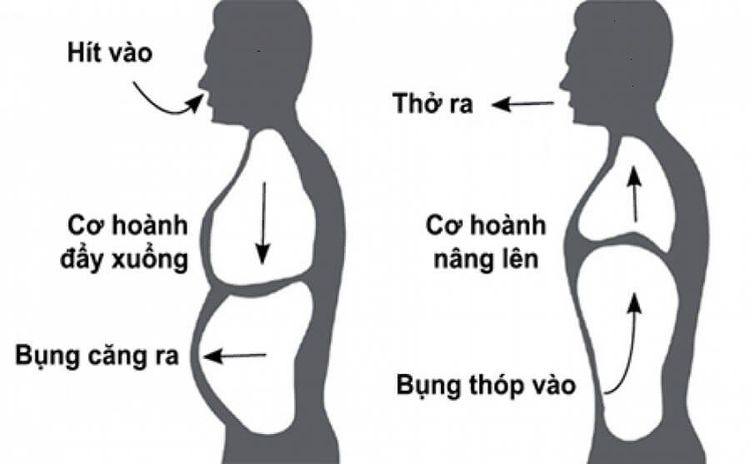
Quá trình hít thở
4. Abnormal signs of the lungs
Signs that may warn of lung problems include:
Change in breathing rate: For an adult, breathing rate is the number of breaths your lungs take in a minute that will be in the normal range from 12 to 20 breaths per minute. More or less of that could be a sign of a health problem that may be directly related to your lungs or other organs involved. Some medical conditions include heart failure, anxiety, asthma, pneumonia, drug abuse, and lung disease. Coughing up blood : Coughing up blood can be seen in some conditions such as tuberculosis , bronchiectasis , lung cancer ... or sometimes there is confusion between vomiting blood . However, regardless of the cause, it is important to see a doctor right away. Shortness of breath: Shortness of breath at rest or even after exercise, is not normal if present for a long time. Especially if breathing difficulty is accompanied by signs of bacterial or viral infection, it is necessary to seek medical attention and treatment immediately. Chronic cough: If a cough occurs after a month, it is called a persistent or chronic cough. Wheezing, wheezing: Wheezing can be caused by something that narrows or blocks your airways. Cough with phlegm : If the cough has sputum on one body, it needs to be treated on a daily basis because it can be caused by pulmonary tuberculosis, chronic bronchitis... Chest pain: This sign is especially worse if it worsens when breathing or cough.
5. Factors that can affect the lungs
5.1. Age As you get older, changes can happen that make it harder for your lungs to do their normal job. These changes include:
Muscles such as the diaphragm, chest muscles begin to weaken. Lung tissue begins to lose elasticity, which can narrow your airways. The bones and muscles in your rib cage can contract, leaving less space for your lungs to expand. Your immune system may not be as strong, making you more susceptible to infections. 5.2. Smoking Cigarette smoke can narrow and inflame your airways and make it harder to breathe. It often irritates the lungs and can cause a persistent cough. Over time, tobacco smoke damages lung tissue and can cause cancer. It is the
1 cause of lung cancer and COPD, a disease that slowly destroys the tiny sacs in your lungs (alveoli) that carry oxygen to your bloodstream.
5.3. Air Pollutants Air contains gases, fumes and dust that can enter the lungs. Makes the lungs more susceptible to damage and attack by microorganisms.
5.4. Microorganisms Fungi, bacteria or viruses are all agents that can significantly affect the respiratory system. They cause an inflammatory response and interfere with gas exchange. In most cases, treatment improves the disease, but people with weak or inadequately developed immune systems are at risk of getting worse.
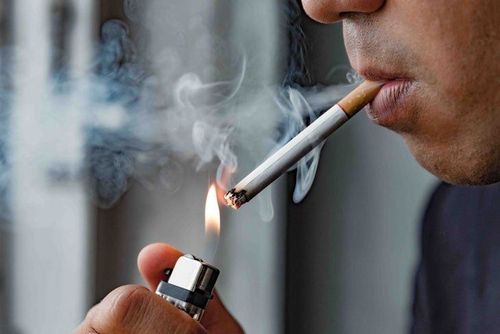
Hút thuốc là tác nhân không nhỏ gây ảnh hưởng tới hai lá phổi có thể gây ra ung thư phổi
6. Some tips to help keep your lungs healthy
To keep your lungs healthy you should do the following:
Exercise regularly: It's not only good for your heart and keeps your body weight in balance. It's also good for your lungs, even if you have lung disease. You can choose any suitable sport such as walking, jogging or playing tennis regularly which can help a lot. Aim for about 30 minutes and five times a week. Breathing exercise: This is a measure to help the alveoli in the respiratory tract work to the maximum. Breathing exercises are very simple and can be thought of as a means of relaxation. You can lie down or sit, then relax your body. Take a deep breath, then exhale through your mouth. Limit contact with people who are suffering from respiratory-transmitted diseases such as measles, corona virus... Air quality should be checked: Places with polluted air quality are at risk of affecting human health. anyone's health. Especially those who are like children, adults over 65 years old and people who are sick. When the level of air pollution is very high, it is safer to stay indoors more often. Here's what you need to know about the lungs. Lungs are very important to us. Therefore, it needs to be cared for and protected from outside influences.
Please dial HOTLINE for more information or register for an appointment HERE. Download MyVinmec app to make appointments faster and to manage your bookings easily.
Reference source: webmd








